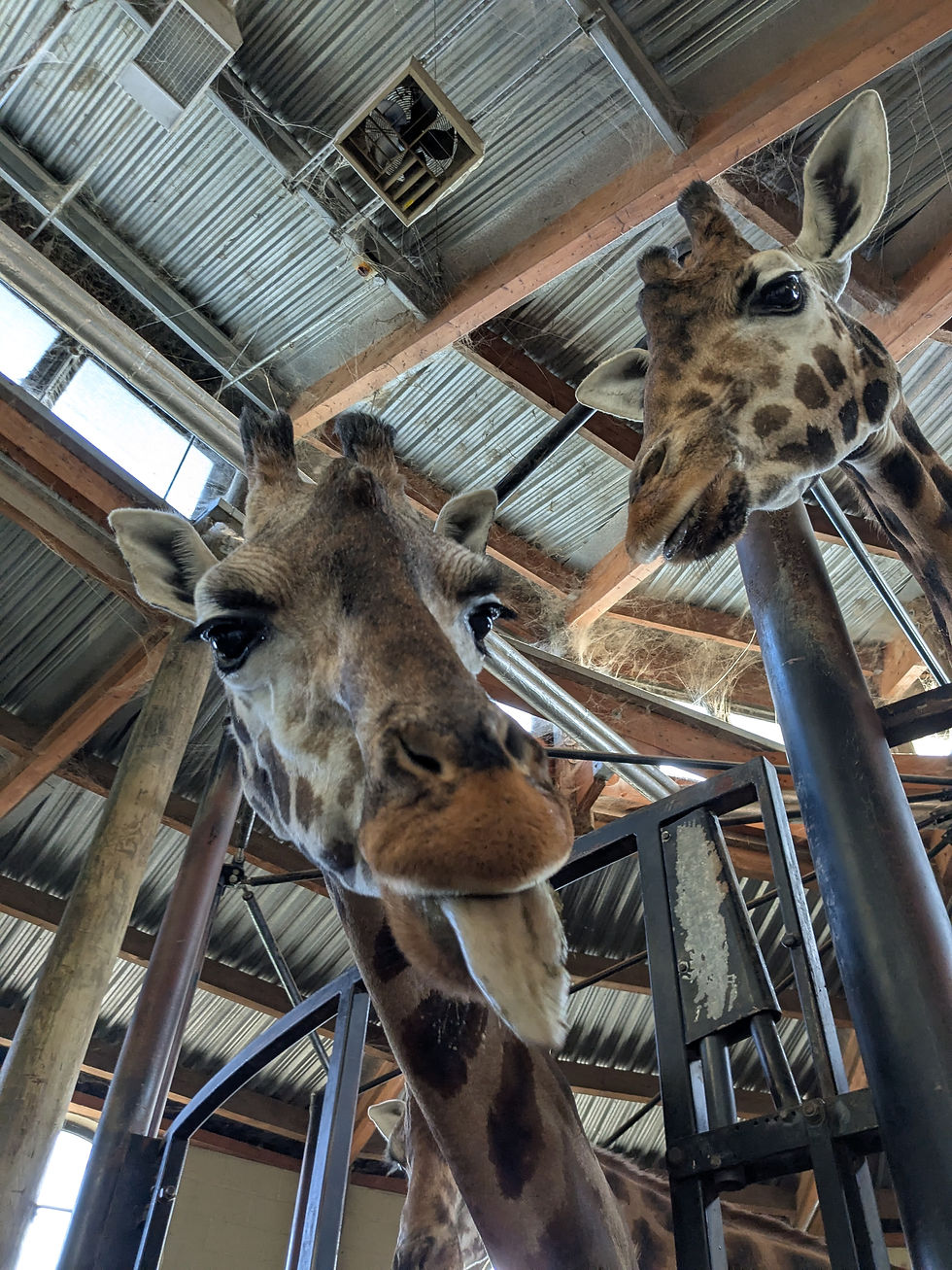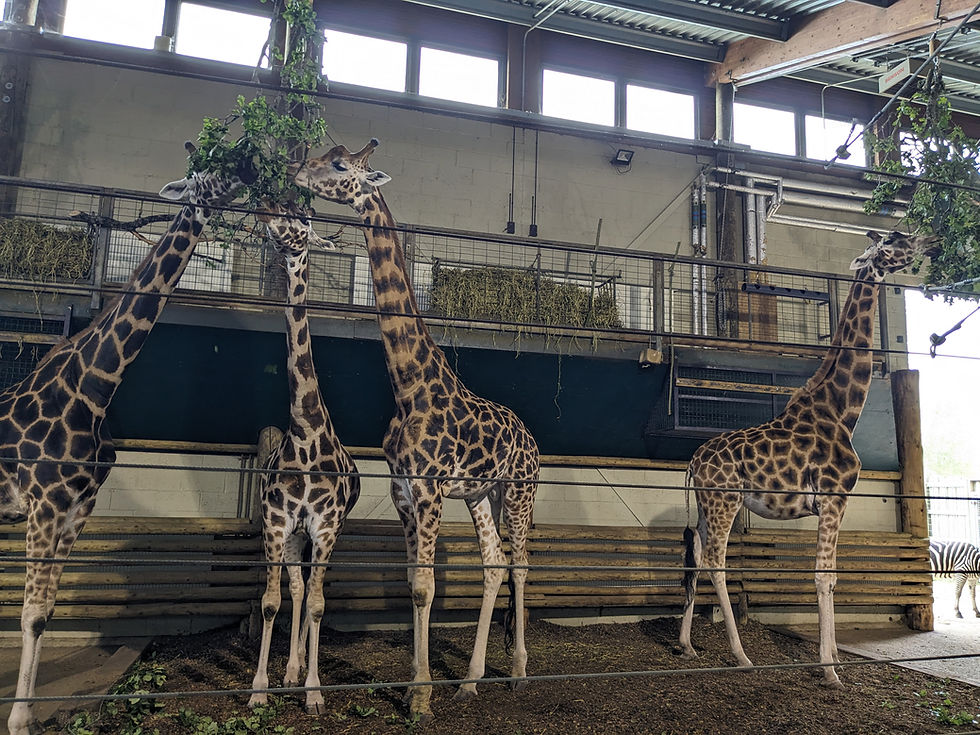New research blog: Trees bring multiple behavioural benefits for zoo-housed giraffes
- laurenjoannemoore
- Jul 25
- 4 min read
Updated: Sep 4
Written by Paul Rose, senior lecturer in Psychology, based in the Centre for Research in Animal Behaviour at the University of Exeter
Link to the paper: https://doi.org/10.1016/j.jveb.2025.05.005
Giraffes are obligate browsing ruminants, evolved to consume the leaves, flowers, and fruits from trees, shrubs, and bushes. This specific ecology causes logistical, financial, and animal management challenges for those working with ex-situ populations. Not only is browse essential to correct giraffe nutrition and energetics, but the act of browsing enables multiple behavioural benefits that positively impact animal welfare. Our study, published in the Journal of Veterinary Behavior, explores how different cut tree branches (“browse” species) affect the feeding behaviour of zoo-housed giraffes and the resulting display of positive welfare indicators (especially time spent ruminating). We collected data over two spring and summer seasons on five female giraffes. We examined their responses to four commonly provided browse species in the UK: goat willow, hawthorn, hazel, and English oak.

Replicating natural behaviours
In the wild, giraffes spend most of their day foraging and ruminating, behaviours that are essential to good physical and mental health. Replicating such natural feeding patterns in zoos is thwarted by the seasonal availability of browse and the practicalities of sourcing a consistent supply. Therefore, we hoped to evaluate which browse species best promoted welfare-positive behaviours to give zoos clues as to where to invest their time and effort in selecting and procuring browse.

The results
Our results show that goat willow encouraged the longest and most consistent browsing times across all giraffes. Some individuals browsed willow continuously for the entire observation period. Oak had a positive impact by promoting rumination and further foraging in the period after the giraffes had first accessed their browse. Interestingly, hawthorn, which we expected to prolong feeding due to its thorny branches and slight similarity to spine-covered Acacia that giraffes have evolved alongside, did not lead to longer browsing times or increased rumination.
In fact, giraffes took fewer bites and chews when feeding on hawthorn, suggesting that this batch of hawthorn may have been less appealing or harder to process. Hazel was the least consumed overall and was associated with shorter browsing periods. However, the study found that giraffes often returned to previously offered browse species later in the day, including hazel. This indicates that even less-preferred options have value as dietary variety and may be consumed gradually over time. Therefore, we concluded that all four tree species has positive impacts on giraffe behaviour and welfare.
Influence of social setting
An important aspect of our study was the influence of social setting. Giraffes were observed to browse more actively when housed with other species such as zebra and antelope, taking more bites and showing a higher rate of feeding. This could suggest that the presence of other animals may stimulate naturalistic foraging behaviour, although the dynamics of competition and access should be considered carefully in mixed-species enclosures. This needs to be replicated across other facilities.

Husbandry implications
Our research also highlights the prevalence of bark stripping, particularly with willow, and found that this behaviour increased with longer browsing sessions and when other species were present. While bark stripping can be a natural behaviour in wild giraffes, more research is needed to understand any potential long-term effects on dental health in captive settings. Bark stripping may be so common in zoos because browse is a limited but very valuable resource. Consequently, the giraffes interact with all aspects of the tree branches as much as they can. In the wild, there would be plenty of new trees to go and consume leaves from.
We calculated that each giraffe, on average, consumed around 4 kg of browse per day during our observation period. This equates to about 25% of their estimated daily dietary intake. This meets current husbandry recommendations for browse provision and reflects the considerable effort made by the giraffe keepers to meet the complex dietary needs of their animals. Nevertheless, the authors encourage zoos to aim for even higher browse amounts, where possible, to better reflect the volume of leaf consumption seen in wild animals.

Guidance to zoos
The study reinforces the concept that browse is not just enrichment for giraffes, but an essential part of their daily care. The type of browse offered significantly influences behaviour and thoughtful selection of browse species can support natural feeding patterns.
Our research offers practical guidance to zoos. Feeding mixed browse bundles may be the best approach, both to provide dietary variety and to reduce the risks associated with plant secondary compounds (e.g., tannins or salicinoids). Providing a mixture of browse species also enables longer feeding sessions and extends time on rumination, allowing giraffes to accrue physical and psychological health benefits. Monitoring giraffe behaviour following browse provision, especially for signs of increased rumination, can assess the effectiveness of feeding strategies and tailor them to individual animal needs.
Conclusions
Ultimately, this research illustrates the value of observing and quantifying animal behaviour as a tool for improving welfare and evaluating husbandry. By understanding which browse encourages maximal beneficial responses, zoos can refine their feeding practices to enable positive welfare outputs. We hope that more institutions will adopt and adapt these methods to continue to research the behavioural responses of zoo-housed giraffes to cut tree branches.
Written by Paul Rose, senior lecturer in Psychology, based in the Centre for Research in Animal Behaviour at the University of Exeter
Link to the paper: https://doi.org/10.1016/j.jveb.2025.05.005

































Comments